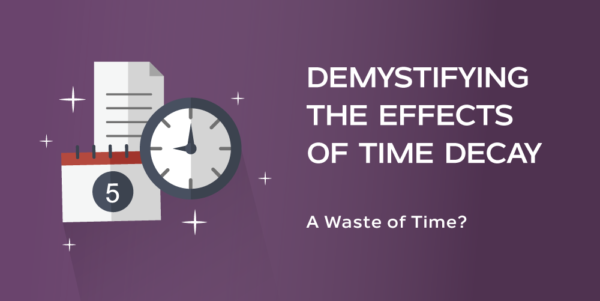
You might be wondering, should I buy options with 30, 60, or 90 days until expiration?
The simple answer is: There is no simple answer. Long options are all susceptible to the effects of theta, or time decay, and as such are wasting assets. The time until expiration may depend on the strategy being utilized, market outlook, and IV levels, among other factors. Here we will outline some of the potential pros and cons of buying options with 30, 60, and 90 days until expiration.
30 days until expiration: Options with 30 days or less until expiration decay at an exponentially faster rate. Every day, every hour, even every minute, these options are losing value if all other inputs remain equal. While this can be a bad thing for the option buyer, it can be a good thing for the option seller. Given their proximity to expiration, options with 30 days or less to go are also not as sensitive to changes in implied volatility as options with more time value. Option buyers may want to avoid such short-dated options.
60 days until expiration: Options with 60 days until expiration will exhibit a significantly slower rate of time decay. That being said, however, these options are still losing value on a daily basis, all other inputs remaining equal. Option buyers may benefit from this slower decay rate while option sellers may be at a disadvantage. With more sensitivity to changes in IV, these options can potentially both help and hurt both buyers and sellers. If IV rises, long option holders may potentially profit while short option holders may potentially experience losses. On the other hand, if IV levels decline, long option holders may experience losses while those short premium may potentially profit.
90 days until expiration: Options with 90 days until expiration will exhibit little noticeable time decay. This can be an advantage to the option buyer and a disadvantage to the option seller. Options with 90 days or more until expiration can potentially have even more sensitivity to changes in IV. For long options buyers, the idea of having a lot of time until expiration may be comforting. Option premiums, however, can become significantly more expensive the further out on the time horizon. Buying calls or puts with so much time on them may potentially be cost-prohibitive for some traders or investors.
When buying options, there are many factors to consider when choosing the amount of time until expiration. Current IV levels, strategy, and market outlook to name just a few. When looking to get a short premium, shorter time frames may be desirable. While shorter time frames may exhibit a faster rate of time decay and less sensitivity to changes in IV, traders have to consider whether or not smaller premiums justify the risk being taken. If buying calls or puts, you have to allow enough time for anticipated market movement. As with any other type of trading, risk should always be your top consideration.










